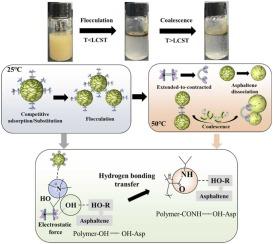Thermally regulated flocculation-coalescence process by temperature-responsive cationic polymeric surfactant for enhanced crude oil-water separation
IF 12.2
1区 环境科学与生态学
Q1 ENGINEERING, ENVIRONMENTAL
引用次数: 0
Abstract
Polymeric surfactants play a crucial role in the flocculation-assisted coalescence process due to their unique bridging effect. However, the steric hindrance induced by their large molecules severely impedes the coalescence of oil droplets. Herein, temperature-responsive polymeric surfactants (quaternary ammonium chitosan-g-PNIPAM, Q-g-PN) with thermally-modulated structure were designed by integrating thermal responsive moieties onto cationic chitosan. The as-prepared Q-g-PN exhibited enhanced oil-water separation efficiency through a thermally regulated flocculation-coalescence process. At low temperatures, the thermal-responsive Q-g-PN remains in a flexible hydrophilic extended state, facilitating the flocculation of dispersed oil droplets through bridging via electrostatic interaction. At high temperatures, the Q-g-PN structure collapses into a hydrophobic coil state, reducing steric hindrance and enhancing hydrogen bonding to asphaltenes, thus effectively promoting oil droplet coalescence. Bottle tests demonstrated that the demulsification performance of Q-g-PN could reach up to 94 % with the Q-g-PN concentration only of 0.001 wt% via the proposed temperature-regulated flocculation-coalescence process, which was further confirmed by investigating oil droplet behavior and phase transition of Q-g-PN during through molecular dynamic (MD) simulation of the reaction process. This work presents new insights into enhancing oil-water separation efficiency by regulating the flocculation-coalescence process through precise modulation of the molecular interactions between polymeric surfactants and emulsion droplets.

利用温度响应型阳离子聚合物表面活性剂的热调节絮凝-凝聚过程增强原油-水分离效果
聚合表面活性剂因其独特的架桥效应,在絮凝辅助凝聚过程中发挥着至关重要的作用。然而,大分子引起的立体阻碍严重阻碍了油滴的凝聚。在此,通过将热响应分子整合到阳离子壳聚糖上,设计出了具有热调节结构的温度响应型聚合物表面活性剂(季铵壳聚糖-g-PNIPAM,Q-g-PN)。制备的 Q-g-PN 通过热调节絮凝-凝聚过程提高了油水分离效率。在低温下,热响应 Q-g-PN 保持柔性亲水扩展状态,通过静电作用架桥,促进分散油滴的絮凝。在高温下,Q-g-PN 结构会塌缩成疏水线圈状态,从而减少立体阻碍,增强与沥青质的氢键结合,从而有效促进油滴凝聚。瓶试结果表明,通过拟议的温度调节絮凝-凝聚过程,Q-g-PN 的破乳化性能可达 94%,而 Q-g-PN 的浓度仅为 0.001 wt%。这项研究提出了通过精确调节聚合物表面活性剂与乳液液滴之间的分子相互作用来调节絮凝-凝聚过程,从而提高油水分离效率的新见解。
本文章由计算机程序翻译,如有差异,请以英文原文为准。
求助全文
约1分钟内获得全文
求助全文
来源期刊

Journal of Hazardous Materials
工程技术-工程:环境
CiteScore
25.40
自引率
5.90%
发文量
3059
审稿时长
58 days
期刊介绍:
The Journal of Hazardous Materials serves as a global platform for promoting cutting-edge research in the field of Environmental Science and Engineering. Our publication features a wide range of articles, including full-length research papers, review articles, and perspectives, with the aim of enhancing our understanding of the dangers and risks associated with various materials concerning public health and the environment. It is important to note that the term "environmental contaminants" refers specifically to substances that pose hazardous effects through contamination, while excluding those that do not have such impacts on the environment or human health. Moreover, we emphasize the distinction between wastes and hazardous materials in order to provide further clarity on the scope of the journal. We have a keen interest in exploring specific compounds and microbial agents that have adverse effects on the environment.
 求助内容:
求助内容: 应助结果提醒方式:
应助结果提醒方式:


